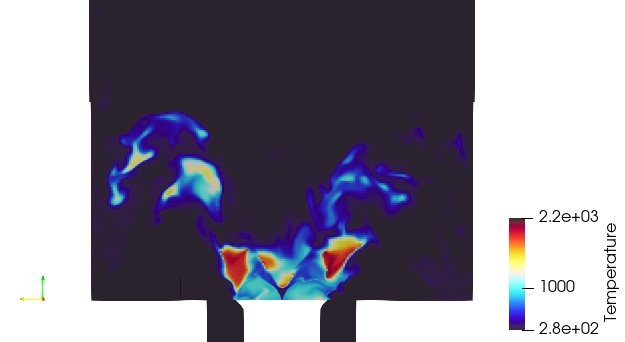Research on numerical simulation techniques for complex flows
JAXA Supercomputer System Annual Report February 2024-January 2025
Report Number: R24EDA201J02
Subject Category: Aeronautical Technology
- Responsible Representative: Abe Hiroyuki, Aviation Technology Directrate, Fundamental Aeronautics Research Unit
- Contact Information: Taisuke Nambu, Aviation Technology Directorate, Fundamental Aeronautics Research Unit(nambu.taisuke@jaxa.jp)
- Members: Hiroyuki Abe, Shingo Matsuyama, Taisuke Nambu
Abstract
Fluid simulation in the aerospace field targets flow fields with turbulence and chemical reactions around aircraft and spacecraft. Additionally, simulations of combustors for gas turbine and rocket engines often involve complex geometries. This study aims to develop numerical simulation techniques that can accurately and efficiently analyze a wide range of physical phenomena and complex geometries.
Reference URL
N/A
Reasons and benefits of using JAXA Supercomputer System
Since turbulence analysis using Direct Numerical Simulation (DNS) and Large Eddy Simulation (LES) is the primary tool in this study, a three-dimensional unsteady analysis must be conducted. Additionally, the governing equations for numerous chemical species generated by chemical reactions must be solved in the analysis of combustion flows. The computational cost of such an analysis is extremely high, making it impossible without the use of a supercomputer.
Achievements of the Year
"Research and development of droplet group evaporation model"
The validation of the newly proposed droplet group evaporation model is conducted, focusing on the quenching limit prediction of the Cambridge Swirl burner. During the validation process, it is confirmed that the influence of other physical models, such as the combustion model, is greater than that of the evaporation model. As a result, improvements are made, including modifications to these models.
"Research and development of RANS stress equation models "
We are developing the Reynolds stress model. In this year, we have tested the prototype model against the 2D zero-pressure-gradient turbulent boundary layer. Since the prototype model gave an underprediction of the mean velocity profile, we have then modified the near-wall expressions in the model. The latter modification reduces a difference in the prediction up to about 50 percent.
"Construction of turbulent jet flow DNS database for SGS modeling"
In order to compile a DNS database that can be used for SGS modeling of turbulent LES, DNS of turbulent plane jets was performed for a wide range of Reynolds numbers from Re=1500 to 70000, and statistical data (mean velocity field, RMS variation field, turbulence statistics, etc.) were obtained.
Publications
- Oral Presentations
1. Matsuyama, Numerical Study on Reynolds Number Dependence of a Turbulent Plane Jet, the 38th Computational Fluid Dynamics Symposium
Usage of JSS
Computational Information
- Process Parallelization Methods: MPI
- Thread Parallelization Methods: OpenMP
- Number of Processes: 1 - 1024
- Elapsed Time per Case: 240 Hour(s)
JSS3 Resources Used
Fraction of Usage in Total Resources*1(%): 1.80
Details
Please refer to System Configuration of JSS3 for the system configuration and major specifications of JSS3.
| System Name | CPU Resources Used(Core x Hours) | Fraction of Usage*2(%) |
|---|---|---|
| TOKI-SORA | 48666966.68 | 2.23 |
| TOKI-ST | 64174.69 | 0.07 |
| TOKI-GP | 0.00 | 0.00 |
| TOKI-XM | 1669.84 | 0.81 |
| TOKI-LM | 754.88 | 0.05 |
| TOKI-TST | 0.00 | 0.00 |
| TOKI-TGP | 0.00 | 0.00 |
| TOKI-TLM | 0.00 | 0.00 |
| File System Name | Storage Assigned(GiB) | Fraction of Usage*2(%) |
|---|---|---|
| /home | 1136.97 | 0.77 |
| /data and /data2 | 110586.28 | 0.53 |
| /ssd | 31621.39 | 1.69 |
| Archiver Name | Storage Used(TiB) | Fraction of Usage*2(%) |
|---|---|---|
| J-SPACE | 29.72 | 0.10 |
*1: Fraction of Usage in Total Resources: Weighted average of three resource types (Computing, File System, and Archiver).
*2: Fraction of Usage:Percentage of usage relative to each resource used in one year.
ISV Software Licenses Used
| ISV Software Licenses Used(Hours) | Fraction of Usage*2(%) | |
|---|---|---|
| ISV Software Licenses(Total) | 437.04 | 0.30 |
*2: Fraction of Usage:Percentage of usage relative to each resource used in one year.
JAXA Supercomputer System Annual Report February 2024-January 2025




